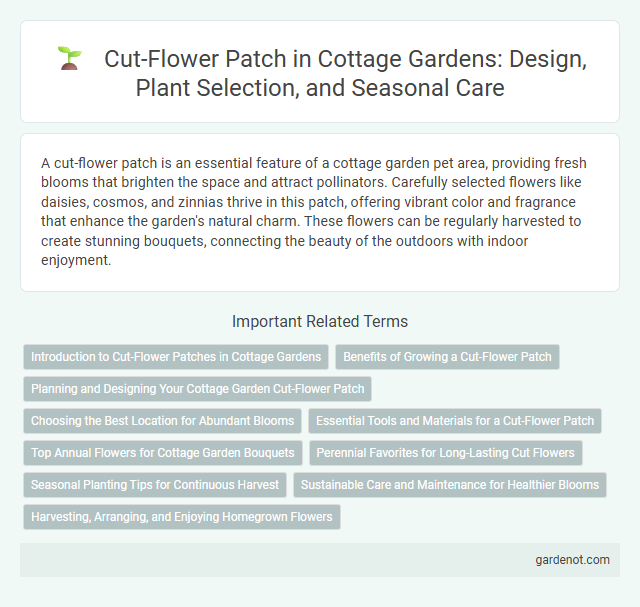A cut-flower patch is an essential feature of a cottage garden pet area, providing fresh blooms that brighten the space and attract pollinators. Carefully selected flowers like daisies, cosmos, and zinnias thrive in this patch, offering vibrant color and fragrance that enhance the garden's natural charm. These flowers can be regularly harvested to create stunning bouquets, connecting the beauty of the outdoors with indoor enjoyment.
Introduction to Cut-Flower Patches in Cottage Gardens
Cut-flower patches in cottage gardens provide a dedicated space for growing an array of vibrant blooms like dahlias, zinnias, and cosmos, ideal for fresh bouquets. These patches enhance garden biodiversity and attract pollinators such as bees and butterflies, supporting overall plant health. Strategic planting in well-drained soil with consistent moisture ensures continuous harvesting and a flourishing floral display throughout the growing season.
Benefits of Growing a Cut-Flower Patch
Growing a cut-flower patch enhances a cottage garden by providing a continuous supply of vibrant blooms for indoor arrangements, enriching home decor with natural beauty. This patch attracts pollinators like bees and butterflies, boosting overall garden health and biodiversity. Cultivating cut-flowers also supports sustainable gardening practices by reducing the need for commercially sourced floral products.
Planning and Designing Your Cottage Garden Cut-Flower Patch
Designing a cottage garden cut-flower patch involves selecting a diverse mix of flowering plants that bloom in succession from early spring to late autumn, ensuring a constant supply of fresh cut flowers. Prioritize hardy, fragrant blooms such as dahlias, foxgloves, cosmos, and hollyhocks planted in informal, naturalistic groupings to capture the quintessential cottage garden charm. Strategic placement near pathways or seating areas enhances both accessibility for cutting and the overall sensory experience with vibrant colors and textures.
Choosing the Best Location for Abundant Blooms
Selecting the ideal spot for a cut-flower patch in a cottage garden involves ensuring full sun exposure for at least six hours daily, which promotes vibrant and abundant blooms. Soil should be well-draining and enriched with organic matter like compost to support healthy root growth and flower production. Proximity to water sources is essential for consistent irrigation, helping to maintain moisture levels critical for cut-flower varieties such as sunflowers, dahlias, and zinnias.
Essential Tools and Materials for a Cut-Flower Patch
Essential tools for a cut-flower patch include sharp pruning shears, a garden knife, and a harvesting basket to protect stems and facilitate easy collection. Quality materials such as biodegradable floral tape, plant labels, and a lightweight watering can ensure proper maintenance and extended bloom life. Using rich, well-draining soil with organic compost enhances flower growth and overall patch productivity.
Top Annual Flowers for Cottage Garden Bouquets
Top annual flowers for a cut-flower patch in a cottage garden include cosmos, zinnias, and sweet peas, prized for their vibrant colors and long-lasting blooms. These flowers thrive in well-drained soil with ample sunlight, providing continuous harvests from early summer through fall. Incorporating marigolds and nasturtiums adds texture and fragrance, enhancing the charm of cottage garden bouquets.
Perennial Favorites for Long-Lasting Cut Flowers
Perennial favorites such as coneflowers, lavender, and peonies thrive in cottage garden cut-flower patches, offering long-lasting blooms ideal for fresh bouquets. These hardy plants provide continuous blooms from late spring through fall, ensuring a steady supply of vibrant flowers. Incorporating perennials reduces replanting efforts while enhancing the garden's visual appeal and floral diversity.
Seasonal Planting Tips for Continuous Harvest
Plant a diverse mix of early spring bulbs, mid-summer annuals, and late autumn perennials in your cut-flower patch to ensure a continuous harvest throughout the growing season. Incorporate fast-growing varieties like sweet peas and zinnias alongside longer-lasting blooms such as dahlias and sunflowers for staggered flowering periods. Regularly deadhead spent flowers and succession plant every two to three weeks to maintain steady blooms and maximize cut-flower availability.
Sustainable Care and Maintenance for Healthier Blooms
Establishing a cut-flower patch in a cottage garden promotes sustainable care by using organic fertilizers and natural pest control methods to enhance soil health and bloom vitality. Regular deadheading and strategic crop rotation minimize disease and encourage continuous flowering cycles, supporting robust plant development. Integrating native pollinator-friendly plants within the patch improves biodiversity and strengthens the overall ecosystem for healthier, longer-lasting blooms.
Harvesting, Arranging, and Enjoying Homegrown Flowers
Harvesting cut flowers from a cottage garden involves cutting blooms early in the morning when petals are freshest, using sharp garden shears to prevent damage. Arranging homegrown flowers benefits from mixing various textures and colors, creating natural, loose bouquets that showcase the garden's charm. Enjoying these vibrant floral arrangements indoors boosts mood and enhances home decor with the authentic scent and beauty of seasonal blossoms.
Cut-flower patch Infographic

 gardenot.com
gardenot.com